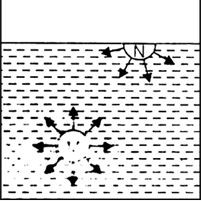 Short Answer Type
Short Answer TypeSeparate portions of chloroform and water at the same temperature are poured on your hands. The chloroform feels colder. Account for this in terms of attractive forces.
 Long Answer Type
Long Answer TypeExplain briefly the boiling point of a liquid. What is the effect of change in external pressure on the boiling point?
 Short Answer Type
Short Answer Type Long Answer Type
Long Answer TypeExplain the term surface tension.

